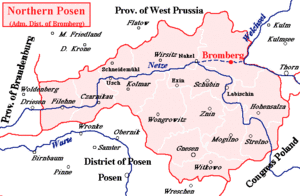Bromberg was the northern of two Prussian administrative regions, or Regierungsbezirke (Polish: Rejencja), of the Grand Duchy of Posen (1815–1848) and its successor, the Province of Posen (1848–1919). The administrative center was the city of Bromberg (Bydgoszcz).
The region was bordered on the south by the Regierungsbezirk Posen, to the west by the Province of Brandenburg, to the north by West Prussia, and to the east by Congress Poland (within the Russian Empire).
The Bromberg region had a larger percentage of mostly Protestant Germans than average for the Province of Posen. Other German speakers were by religion Jewish or Roman Catholic. However, around half the population were Roman Catholic Poles. Initially, there was a sizeable Jewish minority, but that number diminished over time due to the Ostflucht.
Divisions
Note: Prussian provinces were subdivided into units called Kreise (singular Kreis, abbreviated Kr., English "circle"), which were similar to small counties in US terms, "rural districts" in British terms. The larger cities would have their own Stadtkreis (English: "urban district") and the surrounding rural area would be named for the city, but referred to as a Landkreis (English: "rural district"). In the case of Posen, the Landkreis was split into two: Landkreis Posen West, and Landkreis Posen East. The region was originally divided into several larger Kreise, which were later divided into the final 13 Kreise, the larger ones spinning off smaller units.
Demographics
| District | Polish Name | Population | German | Polish | Bilingual | |||
| Bromberg Region | Rejencja Bydgoska | 762,947 | 379,488 | 49.7% | 378,831 | 49.7% | 4,929 | 0.6% |
| City of Bromberg | Bydgoszcz | 57,696 | 46,720 | 81.0% | 9,350 | 16.2% | 1,546 | 2.7% |
| Bromberg | Bydgoszcz | 96,473 | 58,783 | 60.9% | 37,049 | 38.4% | 590 | 0.6% |
| Czarnikau | Czarnków | 42,287 | 30,016 | 71.0% | 12,027 | 28.4% | 176 | 0.4% |
| Filehne | Wieleń | 33,653 | 23.504 | 69.8% | 9,918 | 29.5% | 216 | 0.6% |
| Gnesen | Gniezno | 56,250 | 21,461 | 38.2% | 34,643 | 61.6% | 129 | 0.2% |
| Hohensalza | Inowrocław | 77,294 | 28,394 | 36.7% | 48,599 | 62.9% | 258 | 0.3% |
| Kolmar in Posen | Chodzież | 76,020 | 61,600 | 81.0% | 13,957 | 18.4% | 422 | 0.6% |
| Mogilno | Mogilno | 49,253 | 14,274 | 29.0% | 34,659 | 70.4% | 192 | 0.4% |
| Schubin | Szubin | 48,304 | 21,035 | 43.5% | 26,799 | 55.5% | 403 | 0.8% |
| Strelno | Strzelno | 37,620 | 7,437 | 19.8% | 30,109 | 80.0% | 67 | 0.2% |
| Wirsitz | Wyrzysk | 67,219 | 34,235 | 50.9% | 32,446 | 48.3% | 494 | 0.7% |
| Witkowo | Witkowo | 29,094 | 4,814 | 16.5% | 24,164 | 83.1% | 91 | 0.3% |
| Wongrowitz | Wągrowiec | 52,574 | 16.309 | 31.0% | 35,955 | 68.4% | 212 | 0.4% |
| Znin | Żnin | 40,210 | 10,906 | 27.1% | 29,156 | 72.5% | 133 | 0.3% |
References
- ^ Belzyt, Leszek (1998). Sprachliche Minderheiten im preussischen Staat: 1815 - 1914 ; die preußische Sprachenstatistik in Bearbeitung und Kommentar. Marburg: Herder-Inst. ISBN 978-3-87969-267-5.
